

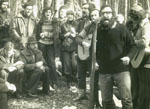
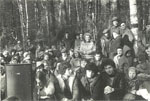

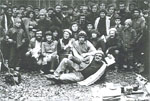




It is 1975. The list of families refused permission to immigrate to Israel is growing. This year, having gotten the first refusal, our family joins the refusenik community.
We have to raise the children, to put food on the table, we must learn what it means to be Jewish beyond it being so written in our passports and�we have to hope that our dream will materialize.
To be together, we need a space � a hall, an apartment if nothing else. But how many refuseniks can we fit into an apartment?
In 1975, at the beginning of the beautiful autumn, we were invited to a get-together outside of the city in a spot that everyone called the �Luntz clearing� (Alexander Luntz was a well-known aliyah activist in the beginning of the 70�s). To get to this place was a bit problematic; one had to take buses from the last metro stop. One bus could hold only a few people, and, in addition to that the bus drivers had been given orders from the KGB not to stop at the bus stop that we needed.
After this get-together, Natan Shwartsman, an experienced hiker and an expert on Moscow surroundings, offered to find a place in the forest that would be accessible by a regional train. Soon, a well situated, large clearing surrounded by birch trees was found. It was located 30 kilometers outside Moscow on the Kazan railroad line, 3 km from the Ovrazhki train station. This is where we began to come together every two weeks, from May (Israel�s Independence Day) to October (the time of Sukkot).
We held out for four years � from 1976 to 1980. Those who came were refuseniks and others Jews who hadn�t yet considered leaving the USSR. We would give out invitations and a train schedule at the synagogue on Arkhipov Street, in Moscow.
In the forest we were always surrounded by the �green patrol� and officers from the KGB.
We had only one goal: �not to let anyone go down alone�, as a well-known Russian poet put it. Our meeting plan was to celebrate holidays together - Independence Day, Lag-ba-Omer, Shavuot, Jerusalem Day, Rosh Hashana, Sukkot - and to familiarize ourselves with Jewish history and culture.
What do we remember most?
� Three festivals of Jewish Song
� Jerusalem Day in 1979
� The tenth anniversary of the Six Day War in 1977
� The Jewish war veterans photo exhibit, celebrating the 35th anniversary of victory over Nazi Germany in 1980
� Maccabiada (celebrating sports) in 1980
� A Torah exam in the forest for children from the underground Sunday school led by Eliahu Essas in 1980.
When at the end of a day spent in the forest, strangers would be thankful for the new experience, for having spent time with their own, among Jews and this was the real reward for the organizers.
In 1980, for the 3rd Festival of Jewish Song at Ovrazhki, 1,200 people showed up in the forest (KGB officials were counting the arrivals at the train station and filming everyone with video cameras). The song festival was a great success. The next morning, two KGB officers were sitting in the office of the Information and Computing Services (ICS) director, where Natan Shwartsman worked at the time. He was told that there is quite a large file with his name on it and that there are many spots left in Siberia where he could go.
They threatened ��We will no longer tolerate your Zionist nest!�
Perestroika was still a long way off. Our fight to emigrate continued. An Israeli song called �Lo nafsik lashir� (�We will not stop singing�) made its way to Moscow. And we sang it with much enthusiasm.
What �Ovrazhki� meant to us in those years was expressed by an anonymous participant of our get-togethers in his poetic note to the leader of the Sukkot festival:
In the cold and rain, the heat and vicious weather,
Through holes in the roof shines upon us a star.
There lies happiness in joining a people,
There lies happiness in returning to a people,
And for this happiness, I came here from afar.
The photographs published in the "Ovrazhki" part are courtesy of Iona and Natan Shwartsman.

|

|

|

|

|

|

|

|

|

|
1980. The next three photos tell of an exhibit commemorating 35 years since the victory over Nazi Germany, which coincided with Israel�s Independence Day. We were acquainted with Efim Gochberg. Himself a war veteran, he collected material about Jewish soldiers and had gathered a lot of information about Jewish war heroes who were awarded the distinction �Hero of the Soviet Union� as well as those who had received three Medals of Glory. We asked him to allow us to show this material during the holiday exhibit at Ovrazhki. Natan Schwarzman and a couple of volunteers put together the display. The late Shimon Yantovsky, also a veteran of the war, told the gathered audience about the role that the Soviet Jews played in victory over Nazi Germany.

|

|

|
The next four photographs were taken in 1980 at a celebration of Lag-B'Omer. This holiday began its history after the destruction of the Second Temple. This is the day when Jews remember the heroes of ancient battles while sitting around camp fires at night. Children shoot bows and arrows, dance and sing songs along with the adults.
In 1980 we found out that a Jewish international sports competition named Maccabiada was taking place in Israel. And so it was decided that, in the forest, we would combine the holiday together with sports.

|

|

|

|
|
The road from the railway station �Ovrazhki� |
Children of the Jewish Kindergarten � Ovrazhki guests, 1978. |
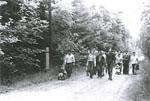
|

|

|

|
The next four photographs capture the �outdoor� Torah exam in Ovrazhki, 1980.
At the end of the school year in the �underground� Jewish school, under the direction of Eliahu Essas, Essas decided that there was no reason to cram everyone into an apartment for the final lesson and that it would be better to invite the parents and grandparents to the �Jewish� clearing so that everyone would hear what the children learned throughout the year. And that�s what was done.

|

|

|

|
The next five photographs show different episodes of our meetings in Ovrazhki devoted to some events, or just friendly gatherings and feasts.
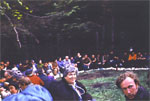
|

|

|
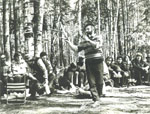
|

|